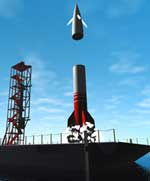
Image credit: Canadian Arrow
Canadian Arrow is pleased to announce that it will begin unmanned test flights of its rocket this summer. The flights, taking place over a period of four months beginning in August, will test the Arrow?s launch pad abort system and escape systems. This testing will be essential before any manned launches are attempted.
The Arrow is currently completing arrangements for the tests at an Ontario location, which will be announced at a future date. The tests will include:
? A launch pad abort test, including testing of the powerful solid rockets that pull the crew cabin to safety in the event of problems while the rocket is on the pad.
? Separation of the nose cone from the crew cabin.
? Deployment of parachutes for safe recovery of the nose cone and crew cabin.
? Testing of aerodynamics to ensure the rocket is able to reach the correct altitude and does not display any flight characteristics that are not normal to flight.
? A mach 1 abort and high altitude abort (application for permission to fly currently being processed)
Specifications of escape system:
? Eight 1,200 lb thrust solid rocket engines that burn for 5 seconds, mounted in a 22-ft tall nose cone
? Two main parachutes 64 ft in diameter
? Onboard computer to record data including acceleration, vibration, pitch, yaw and roll of the rocket.
? Onboard video camera aimed out the same window as the astronauts will use. Video will be available to the media after the flight.
? Vehicle will weigh 2,500lbs at liftoff.
? Crew cabin (space capsule) designed to carry three astronauts 65 inches in diameter and 6 ft tall.
The Canadian Arrow will also fly its first XPOD experiment, produced by students at the Canadian Arrow Science Club at John Dearness School in London. The flight will test the durability of the XPOD. Canadian Arrow is a London-built rocket, competing for the $10 million (US) X PRIZE, which will go to the first team that can launch a passenger space vehicle 100 kilometres into space, land safely and repeat the feat within two weeks.
Original Source: Canadian Arrow News Release
